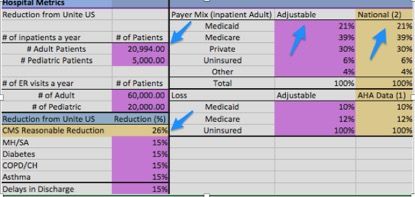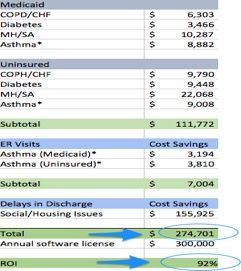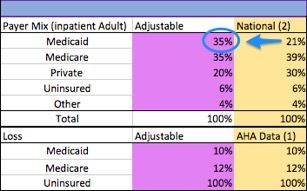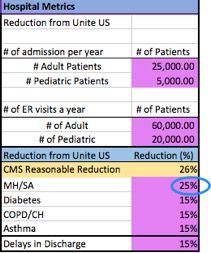Article
The ROI of Addressing Social Determinants of Health
Author(s):
Convincing your chief financial officer to invest in technology that addresses patients’ social determinants of health.
This article was co-written by Daniel McConnell, MD-MBA candidate at Columbia University. The research analyst was Christian Madrazo, BSN, of the University of South Carolina.
Hospital chief executive officers and chief financial officers (CFOs) are seeing an increasing number of investment requests for social determinant of health (SDoH) solutions. One reason for that may be that the move to value-based care is evolving from diagnosis and treatment to community-based patient engagement. And, while population health executives recognize the wisdom of this evolution, they struggle to prove a tangible return on investment (ROI) for allocating budgets to address the SDoH via innovative technology.
This article proposes an ROI argument for requesting budget from your CFO. Our aim is to demonstrate a measurable ROI by connecting cost avoidance opportunities to the leading medical conditions that drive readmission rates for high utilizers.
Additionally, the authors have developed and included an ROI calculator that outputs the financial cost avoidance opportunity impact for such an investment.
Trend versus reality when addressing SDoH
As population health professionals look for new ways to enhance their stewardship of vulnerable populations, many are actively collaborating with community service providers. This trend is center stage at healthcare conferences, where addressing the SDoH is frequently discussed as a strategy to improve patient care and drive better financial results.
Unfortunately, reality doesn’t reflect this trend1:
- More than 72% of hospitals still do not have a dedicated budget to support population health initiatives.
- Two-thirds of hospital electronic medical records do not screen for patient’s social and behavioral needs.
What’s the problem?
If population healthcare executives realize the importance of addressing SDoH, why is it such a challenge securing budget to act on this realization? The simple answer is competing priorities and limited funding. Because healthcare is in constant state of change, new approaches, innovative technologies, and improved processes continually compete for budget. Consequently, justifying new investments requires a believable ROI. Without a substantial financial argument, promising new solutions will not rise to the top of the list of projects considered for funding.
Common goals, but competing priorities
Senior hospital leaders in finance, operations, and population health share common goals; they want to provide safe, effective, innovative, and patient-centered high-quality services. Nevertheless, they also face competing operational priorities. While physicians and population health executives seek patient care quality improvements, their C-suite counterparts struggle to deliver financial efficiencies.
Instead of competing, these 2 types of leaders need to collaborate to find a logical balance between their drive to continually innovate and the need to remain financially viable.
Learning to speak the language of finance
According to the Advisory Board, “most financial leaders have, at one time or another, struggled to communicate with physicians about financial issues. Numerous administrators report that sometimes they come away from financial discussions feeling as if they have been speaking a foreign language.”2 No doubt, physicians feel the same, as many are not fluent in the language of finance.
Consequently, population health leaders who seek funds to improve patient care must learn to converse in the language of the financial executive. By doing so, they will translate care quality outcomes into financial benefits their CFO can understand, which may increase their chance of funding.
The first step? Understanding what ROI is and how it can be used to request funding for software that addresses SDoH.
What is ROI?
Unlike a cost-benefit analysis, which looks at both the financial and non-financial benefits of a new project, ROI is purely a financial exercise to ascertain the financial return of a specific dollar investment.
Example: Let’s assume we wanted to invest $10,000 a year in software that promised to reduce 1000 employee hours per year. If the hourly employee rate was $20, we would reduce annual costs by $20,000 (1000 hours times $20/hour). So, the ROI (as a percentage) would be the projected financial return divided by the initial investment multiplied by 100. In this case, this investment would have yielded an ROI of 200%. ([$20,000/$10,000] x 100 = 200%)
Typically, the goal is to identify a tangible metric (such as hours saved), and calculate this metric into a precise financial return (such as dollars saved or dollars made).
Use ROI metrics with direct cause and effect
It is important to select an ROI metric that has a direct and clear-cut cause and effect. In our example above, we selected “employee hours saved,” because there is a direct cause-and-effect relationship between employee hours saved and cost avoidance associated with this reduction. If we had selected “additional revenues” as the metric of our ROI, this would make our argument more ambiguous, and therefore harder to prove, because there are many variables that can claim a cause-effect relationship on revenues.
Hint: When running a ROI calculation for investing in a technology to address SDoH, seek a ROI metric with direct cause-and-effect relationship with cost. In the model proposed in this article, we will use “hospital readmissions” as the metric we want to use to cut costs.
Start with a clear hypothesis
Example for this article: “By investing $300,000 per year for a software that addresses patients’ SDoH, we will reduce patient readmissions rates by 25% and yield a cost avoidance of $274,000 per year.”
Your ROI journey should always begin with a clear hypothesis. This is where you state your argument. Make a claim in a sentence or 2, and clearly state how much you intend to invest and how much you expect to get back in return.
Always aim for a believable ROI, rather than an extraordinary one
Hint: Aim for a low-hanging fruit like “timely payback”.
When the quality impact of a solution is abundantly evident and important (such as improving quality of care or saving lives), you don’t need to prove a formidable ROI to get funded. The key is to focus the ROI on how the investment will pay (or almost pay) for itself. The quicker the payback, the easier it is to get funding.
When trying to prove an ROI, it is not necessary to pitch significant magnitudes of financial impact. It is more important to make your ROI believable. So, aim for a modest ROI.
Link your ROI to multiple variables
Example: Since in our SDoH example, the organizational metric we want to impact is “avoidable readmissions,” we need to link this core metric to multiple variables—in this case multiple medical conditions that drive readmissions. Then, for each condition, we need to establish that addressing SDoH will reduce the rate of readmission, lead to cost avoidance, and generate an attractive ROI. Finally, by adding up the impact of all the variables (medical conditions) covered in the ROI model, we will generate the total ROI impact.
Hint: The more variables you can link into the core metric that drives your ROI, the more cogent and believable your ROI becomes.
Once you have a solid and believable hypothesis, your next step is to identify and isolate the variables that will drive your ROI. Your best route is to tie the ROI to a metric that your organization already keeps track of, and then link multiple variables to that metric. By feeding the ROI with multiple variables, you will ensure that, even if 1 or 2 variables fluctuate in the wrong direction, your ROI claim will remain fundamentally intact.
Developing your ROI with our ROI calculator
This article includes an ROI calculator to help you develop the ROI for investing in a technology to address SDoH. (Download here) The calculator is designed to adapt to your specific hospital reality, allowing you to adjust the cost of stay by medical condition, the rate of readmissions, and the percentage of Medicaid patients your hospital serves. All pre-populated data is based on national averages based on CMS and American Hospital Association data.
ROI model approach
We developed the ROI calculator based on the argument that by effectively addressing SDoH of vulnerable populations, we can reduce readmission rates, driven by 6 medical conditions. These conditions (our variables) include mental health, substance abuse, diabetes, chronic obstructive pulmonary disease (COPD), congestive heart failure (CHF), and asthma (on an out-patient basis). Each is generally known to drive 30-day readmissions.
By focusing on readmissions, we use a metric that is already top-of-mind with the C-suite of healthcare systems. We then feed the ROI with a “potential readmission reduction” number. This number will fluctuate depending on a hospital and community’s population realities.
While hospital readmission rates are not an exact proxy for all hospital admissions, up to 80% of the time, patients are readmitted3 to the same hospital that they were admitted to before. That means, by addressing the social determinants of health that contribute to adverse health outcomes, hospitals can cut costs and increase efficiency. We chose to focus on 30-day readmissions, because this has major policy implications with regards to Medicare reimbursements, and is a commonly utilized metric of hospital performance.
The logic behind our ROI model
Our ROI model begins with an assessment of the total number of admissions per year. From this number, we extrapolate the percentage of Medicaid and uninsured patients. This provides us with the population upon which the ROI will be computed. (For more information about calculation details, see the Appendix on the last page.)
Then, we divide Medicaid readmissions into six medical conditions, and assess the average cost per stay for each.
Finally, we apply a potential readmission avoidance number driven by addressing SDoH.
The most significant assumption that drives the ROI is the readmission avoidance number for each medical condition. The national benchmark readmission avoidance number we are using in our ROI calculator is 26%. This is an estimated number deducted from a body of articles and research available in the reference section.3,4 However, the ROI calculator gives you the opportunity to customize this number for each medical condition to reflect your individual community and hospital reality.
Using the ROI calculator
Let’s open and explore our Excel ROI Spreadsheet.
The first tab, titled “Total Return,” is the control center (Graphic 1). Within this tab, you can customize input variables based on your hospital’s reality by adjusting the number of patients, number of admissions, percentage by payer type and by medical conditions, readmission reduction by condition, and loss ratio.
Note: The column on the far right titled “national” always remains fixed. This column is fed by CMS national average data and provides a national benchmark for your specific hospital’s metrics. The column titled “adjustable” is where you can input your hospital figures, such as the percentage of Medicaid, Medicare, private, and uninsured patients served. The purple cells in the far-left column allow you to customize the number of inpatients you see per year, and define the percentage of readmission by specific medical conditions.
Graphic 1: Total Return tab, top portion

Once you set these figures in your control panel, the lower part of the spreadsheet (Graphic 2) will automatically update to show the cost avoidance opportunity by medical condition, and summarize your ROI.
For example, if we keep the payer mix as 21% for Medicaid and 6% for uninsured (in Graphic 1), assuming we invest $300,000 per year for a SDoH software, we will generate $274,701 in cost avoidance or a 92% ROI (Graphic 2). So, the software nearly pays for itself every year.
Graphic 2: Total Return tab, bottom portion

By changing the adjustable fields, you can customize the calculator to fit your hospital’s numbers. For example, if 35% of those served by your hospital are Medicaid patients, you can adjust that percentage in the purple column (Graphic 3).
Graphic 3: Adjust the percentage in the Total Return tab

And, if you believe that mental health and substance abuse can potentially reduce readmissions by 25%, then a $300,000 annual investment could yield cost avoidance of $336,930 or a ROI of 112% (Graphic 4).
Graphic 4: Adjustments at the top of Total Return tab result in different ROI


The next 4 tabs provide detail by specific medical condition, including the number of admissions per medical condition, the percentage and the number or readmissions and the average cost per stay. They also present the potential cost avoidance from reduced readmissions.
The last tab, titled “Delays in Discharge,” accounts for the cost associated with delayed discharges.
Getting the funding for your SDoH initiative
Although most agree that addressing high utilizers' SDoH lead to better patient health, healthcare professionals often struggle to establish a concrete ROI for investing in SDoH software. The challenge rests in presenting a tangible and measurable financial outcome and effectively answering the question, “What is the ROI of addressing the SDoH?”
With our ROI model and calculator, you can illustrate the financial impact of such an investment, and show your CFO how that investment can lead to reductions in readmissions from leading medical conditions and, ultimately, to cost savings for the hospital. Armed with that argument and the finances to back it up, you should be able to convince even the toughest CFO to fund your SDoH initiative.
If you have any questions about the model, email ara@uniteus.com.
References
1. Lee J, Korda C. Social determinants of health: How are hospitals and health systems investing in and addressing social needs? https://www2.deloitte.com/content/dam/Deloitte/us/Documents/life-sciences-health-care/us-lshc-addressing-social-determinants-of-health.pdf. Accessed January 9, 2018.
2. Johnston J, Joseph V. Do your physicians speak finance? Advisory Board. https://www.advisory.com/research/financial-leadership-council/at-the-margins/2017/08/do-your-physicians-speak-finance. Accessed January 9, 2018.
3. Reidhead M, Kun HB. Before penalizing hospitals, account for the social determinants of health. NEJM Catalyst. https://catalyst.nejm.org/penalizing-hospitals-account-social-determinants-of-health/. Accessed January 9, 2018.
4. Beaudoin D. Health systems tackle the social determinants of health to reduce readmissions and improve outcomes. Deloitte Center for Health Solutions. http://blogs.deloitte.com/centerforhealthsolutions/health-systems-tackle-social-determinants-health-reduce-readmissions-improve-outcomes/. Accessed January 9, 2018.
Appendix
Calculation details
Each calculator starts with the average number of patients that a hospital will see in a given year, broken down by age (adult vs pediatric) and location (inpatient vs emergency department [ED]).
You can adjust these numbers to fit the size and characteristics of your hospital. We primarily looked at the number of adult patients, except for asthma, in which we included a pediatric component.
We further segmented the number of patients by their expected payer (ie, Medicare, Medicaid, commercially insured, uninsured, etc), based on national averages we sourced from Healthcare Cost and Utilization Project (HCUP). The national averages are listed in one column; you can enter the number tied to your specific institution in the adjacent column. This lets you benchmark against national averages and adjust your figures to fit the realities of your hospital system. For instance, a safety net hospital would likely see higher rates of uninsured and Medicaid individuals than a community hospital in a higher income area.
We further break down the number of expected patients by readmission rates within each payer group. This gives us the number of 30-day readmissions a hospital would expect in a given year. Our numbers are also sourced from HCUP and are tied to their specific payer. Readmission is defined as a 30-day readmission to the hospital for a condition identified as the initial cause for their hospitalization.
We then multiply the number of readmissions by payer for a given hospital by the percent of readmissions by each medical condition, to give the number of readmissions, by condition, that a hospital would experience.
The costs per stay are based on national averages sourced from HCUP.
The loss percentage is derived from American Hospital Association material, and shows the expected loss a hospital would expect from every dollar spent vs reimbursement. Care should be taken with regard to this number and its sourcing.
The Medicaid readmission avoidance estimate is based on CMS material for a reasonable reduction that a hospital could achieve.
Why did we choose these medical conditions?
We define them, and explain, below:
Mental Health and Substance Abuse
Adverse health outcomes, due to substance abuse, carry strong socioeconomic risks that can increase both hospital admissions and readmissions.1 For example, homeless drug users are more likely to engage in high-risk sexual activity and carry a higher risk of infectious disease transmission.
Treating substance abuse would contribute to the reduction of readmission rates and help health systems that work within communities with large numbers of these individuals save money. The rise of the opioid epidemic in the United States has brought this issue to the forefront.
Mental health also has a strong social determinant of health (SDoH) component. For example, patients with affordable, healthy housing have been shown to have better mental health outcomes and lower substance abuse than those who don’t have access to clean, safe, and reasonably priced housing.2
Note: The mental health and substance abuse calculator is based on national averages, without regard to patients treated in dedicated substance abuse and mental health facilities. Therefore, these numbers are more accurate for facilities with dedicated inpatient mental and substance treatment. Still, these numbers only look at readmissions and their associated costs. Savings could be higher when looking at a window beyond the standard 30 days, or admissions that are complicated with mental health as a comorbidity.
Diabetes
Many diabetes patients are readmitted to the hospital following discharge because of social factors, such as the inability to obtain or take medications, and lack of transportation or knowledge about healthy food preparation.3 Typically, outpatient interventions and community resources would work to address these issues. For instance, patient may lack the finances to obtain proper medication or access to transportation to and from outpatient appointments, so they can better control their blood sugar control.4
Diabetes itself is associated with many disease states and comorbidities, including depression,5 cardiovascular, renal and ophthalmic issues.6 Control of diabetes could lead to cost savings in preventing readmissions for other disease states.
COPD/CHF
Both chronic obstructive pulmonary disease (COPD) and congestive heart failure (CHF) have SDoH interventions that could greatly reduce readmissions rates. A CHF patient’s socioeconomic factors, living situation, and social support all play a role in mortality and readmission following a hospitalization7; therefore, it is in the hospital’s best interest to target these issues. Good follow-up with outpatient providers8 has also been shown to decrease readmissions, and developing strong visibility for case managers who work with these patients would ensure better follow-up.
Note: The HRRP penalizes hospitals if their readmission rates are greater than their calculated, expected rates. The penalty applies broadly, across all Medicare reimbursements for all disease processes, not just those it is measured against. This broad reduction can be up to 3% of all reimbursements. This added cost is not included in the calculator and the costs savings included follow the general framework of expected cost over expected reimbursement.
In COPD, psychosocial factors have been shown to be a key risk factor for readmissions.9,10 Expected readmission reductions were included in the return on investment (ROI) calculator to give a sense of the number of readmissions a hospital could expect, since these numbers have a direct effect on the Hospital Readmissions Reduction Program (HRRP)11.
Asthma
Asthma is different than the other 3 medical condition pathways in terms of its contribution to the ROI calculator. Asthma is a chronic condition that should be managed almost exclusively in the outpatient setting, without the need for hospitalization or emergency visits, except in severe cases. Hospitalization and ED visits are not entirely preventable, but strong community-based interventions that target home conditions and patient education have been shown to be effective in preventing ED visits and subsequent inpatient treatment.12,13
Unlike the other medical conditions, asthma commonly affects children and is one of the most common causes of hospital admission worldwide.14 Good control over the illness should prevent the need for ED treatment.
The percent of asthma admissions was calculated for both adult and pediatric patients based on national numbers. This was multiplied by the number of patients that a hospital would see from each group and further broken down by payer. The same was done with regard to ED visits. We only included children covered by Medicaid, since most children are insured by private insurers or by Medicaid or the Children’s Health Insurance Program. For adults, we included uninsured patients as well, since this group is more likely to be uninsured than children.
Delay in discharge
The SDoH also contribute to discharge delays, which have been called “bed-blocking” by some. Our calculators take a simplistic view of this complex situation, but include it none-the-less. Discharge delays are faced by every hospital, and contribute to the increase in healthcare costs.15 They may be caused by issues with the patient’s family, or delays in social services for psychiatric patients.16
Our calculators use the number of patients a hospital would expect to see, multiply it by the percent of patients with delayed discharge, the percent delayed to housing and social issues that can be addressed, the average number of delayed days and the cost per day, to give a total cost of a hospital system due to social issues. This is then multiplied by the expected reduction in these days to give a cost savings. The calculators look at 3 payer groups to give a total potential savings: uninsured, Medicare, and Medicaid. It ignores potential savings from moving patients from the ED to the floor that could be avoided by reduced “boarding.”
References
1. Galea S, Vlahov D. Social determinants and the health of drug users: socioeconomic status, homelessness, and incarceration. Public Health Rep. 2002;117(Suppl 1):S135-S145).
2. CSH. Housing is the Best Medicine. Website: http://www.csh.org/wp-content/uploads/2014/07/SocialDeterminantsofHealth_2014.pdf. Published July 2014. Accessed January 9, 2018.
3. Rubin DJ, Donnell-Jackson K, Jhingan R, Golden SH, Paranjape A. Early readmission among patients with diabetes: A qualitative assessment of contributing factors, J Diabetes Complications. 2014;28(6):869-873. doi: 10.1016/j.jdiacomp.2014.06.013. Epub 2014 Jun 28.
4. Dungan KM. The effect of diabetes on hospital readmissions. J Diabetes Sci Technology. 2012;6(5):1045-1052. doi: 10.1177/193229681200600508
5. Katon WJ. The comorbidity of diabetes mellitus and depression. Am J Med. 2008;121(11 Suppl 2):S8-S15. doi: 10.1016/j.amjmed.2008.09.008
6. Simpson SH. Corabian P. Jacobs P. Johnson JA. The cost of major comorbidity in people with diabetes mellitus. CMAJ. 2003;168(13):1661-1667.
7. Calvillo-King L, Arnold D, Eubank KJ, et al. Impact of social factors on risk of readmission or mortality in pneumonia and heart failure: systematic review. J Gen Intern Med. 2013;28(2):269-282.
8. Adib-Hajbaghery M, Maghaminejad F, Abbasi A. The role of continuous care in reducing readmission for patients with heart failure. J Caring Sci. 2013;2(4)255-267. doi: 10.5681/jcs.2013.031.
9. Coventry PA, Gemmell I, Todd CJ. Psychosocial risk factors for hospital readmission in COPD patients on early discharge services: a cohort study. BMC Pulm Med. 2011;11:49. doi: 10.1186/1471-2466-11-49.
10. Wong AWM, Gan WQ, Burns J, Sin DD, van Eeden SF. Acute exacerbation of chronic obstructive pulmonary disease: influence of social factors in determining length of hospital stay and readmission rates. Can Respir J. 2008;15(7)361-364.
11. Joynt KE, Jha AK. A path forward on Medicare readmissions. NEJM. 2013;368(13):1175-1177. doi: 10.1056/NEJMp1300122.
12. CDC. National Asthma Control Program: potentially effective interventions. Website: https://www.cdc.gov/asthma/interventions/interventions_info.htm. Accessed January 9, 2018.
13. Morgan WJ, Crain EF, Cruchalla RS, et al. Results of a home-based environmental intervention among urban children with asthma. NEJM. 2004;351(11):1068-1080.
14. Schultz A, Martin AC. Outpatient management of asthma in children. Clin Med Insights Pediatr. 2013;7:13-14. doi: 10.4137/CMPed.S7867.
15. Rojas-Garcia A, Turner S, Pizzo E, Hudson E, Thomas J, Raine R. Impact and experiences of delayed discharge: a mixed-studies systematic review. Health Expect. 2017;21(1):41-56.
16. Wilder Research. Reasons for delays in hospital discharges of behavioral health patients. Website: https://www.mnhospitals.org/Portals/0/Documents/policy-advocacy/mental-health/MHA%20Mental%20Health%20Avoidable%20Days%20Study%20Report%20July%202016.pdf. Published July 2016. Accessed January 9, 2018.

Navigating Sport-Related Neurospine Injuries, Surgery, and Managed Care

Navigating Sport-Related Neurospine Injuries, Surgery, and Managed Care
2 Commerce Drive
Suite 100
Cranbury, NJ 08512
© 2025 MJH Life Sciences® and AJMC®.
All rights reserved.




